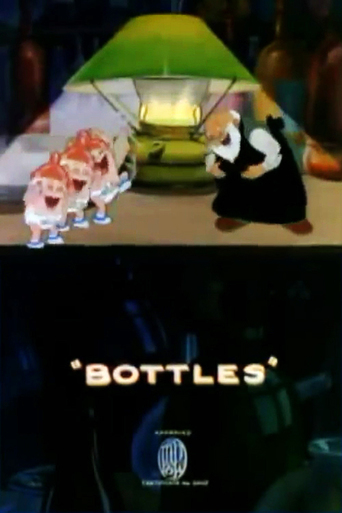

. . . of the genuine article that MGM producers Harman and Ising were starting to churn out in their earlier Warner Bros. days. BOTTLES never misses an opportunity to pull a punch, especially with its "This was all a dream" hackneyed closing. These bloated BOTTLES drag on for at least 25% longer than a comparable Warner Bros. Looney Tune, while encompassing well under half the action. None of the many "Things in a store come to life after hours"-themed Looney Tunes feel the need to include the trite and unnecessary framing device found here. The sight gags and puns in a Looney Tune of this nature are twice as clever, and come three times as fast. The "Ammonia Spirits" chase scene in BOTTLES is totally Lame & Tame compared to those packed into the final half of even a sub-par Looney Tune. The latter's cutting-edge ethnic humor with Pancake Mixes, Tamales, and the Gold Dust Twins also is MIA in these pathetic BOTTLES. In summary, BOTTLES are for babies!!
... View MoreWorking late one night an elderly chemist appears to be attacked in his sleep and shrunken down to bottle size by a wicked bottle of poison with a skull for a top and discovers that after dark all of the bottles in his store come to life to cavort and sing, while a couple of more sinisterly-designed containers plot something nasty for him in a more traditionally eerie dark corner of the dwelling... The idea of this short is pretty neat, although humble bottles by their very mundane nature sure ain't the most inspired of things with which to base a short cartoon around. But it's surprising just how creative they managed to be with such a different strange premise, and there's a good amount of striking and delightful sight gags involving the anthropomorphic bottles playing up to their namesakes, like the cold cream bottles have colds and are warming themselves by a little fire, annoying baby bottles wail in unison, ammonia spirits are literally spirits, and so forth.. Some of the gags are obvious and some not so, I love the red water bottle singing in a fine deep baritone out of its floppy mouth, and also the Indian ink charming a coil of toothpaste like a snake! The witch-hazel witch, poison skeleton and trio of ammonia spirits are some genuinely spooky creations I must say, great well placed touch of the macabre they made. The cackling skeleton is way scarier than the teeth chattering terrors from Disney's The Skeleton Dance! The short really kicks it up a notch when the skeleton seizes the poor old man and distils him through twisting tubes until he pops out the other end as tiny versions of himself which the fiend then sucks up with a syringe and injects into a bottle which he then attacks with scissors! And at the end, although what's revealed is an often-used plot device it's a good use of it. It does beg the question though, to have experienced such a bizarre and startling dream, did the old man inhale the vapours of some of his wares without realising it? It has an admirable amount of creativity put into it, and to say it was made in 1936 the animation is beautifully coloured and amazingly fluid. It's very old but nonetheless is a pretty cool and impressive short, it does command a certain unique niche amongst the legions of vintage animations. Good show!
... View MoreAgree with previous poster, this cartoon is fantastic on so many levels.I find it very warming, a treat for the eyes and ears, the only shame is it's over so soon.Remember watching this over 30 years ago when I was a kid, that skeleton-bottle, it scared the life out of me but I loved those singing baby-bottles. Watching it again is a real trip.I also agree, it's long time overdue for a DVD release of these gems. Those geniuses who created these deserve no less.Brilliant.
... View MoreI saw this when I was about 10 years old, but it has only seemed to be available on laser disc up until its recent release as one of the extras on the DVD release of 'San Francisco'. It's exactly as surreal and fun as I remember! With the 'death walks tonight!' croaks of the animated poison bottle, it seems to convey a sense of foreboding, as if people at the time could sense the war that was coming only three years later. Some fantastic ideas, like the Spirits Of Ammonia, the Baby Bottles and the Cuban rum bottles. Some nice rotoscoping as well, in the Cuban sequence. They really did make them better back then. Contrast this or Max Fleischer's Superman series with the half-hour toy ads like He-Man that were cranked out in the 80's. My 3-year old gets to watch as many of these, and Betty Boop and old Popeye as he likes, so that he knows the good stuff!
... View More